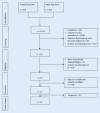[Apps for tinnitus? A systematic review on quality, intervention components, and behavior change techniques]
- PMID: 38085358
- PMCID: PMC10834554
- DOI: 10.1007/s00103-023-03805-1
[Apps for tinnitus? A systematic review on quality, intervention components, and behavior change techniques]
Abstract
Background: Various smartphone applications (apps) for people with tinnitus are available and promise tinnitus relief. Yet, it is difficult for people suffering from tinnitus and healthcare professionals to estimate their quality, potential, or risks. The current study aims to generate an overview of available tinnitus apps in the German language and to offer orientation for research and healthcare providers.
Method: The most prominent stores were searched systematically (November 2020-April 2021; Google Play Store and Apple App Store). Apps specifically developed for tinnitus were evaluated by two independent raters using multiple approaches: a) a quality screening was performed using the German version of the Mobile App Rating Scale (MARS-G), b) intervention components were assessed using a newly developed list of categories, and c) implemented strategies for active tinnitus management were analyzed using behavior change techniques (BCTs).
Results: The search yielded 1073 apps, of which 21 apps were analyzed. The apps' overall quality as assessed by MARS‑G was average (M = 3.37, SD = 039). A lot of apps offered sounds (n = 18) and information (n = 9) or assessed tinnitus characteristics (n = 13). Out of 93 BCTs, 24 were identified at least once. Only one app was evaluated in non-randomized trials.
Conclusion: Although a variety of apps are available, most of them focus on a few intervention components (e.g., sounds or information). Therefore, apps do not exploit their potential to impart important evidence-based content for tinnitus management. The app evaluation using multiple approaches points out potential for improvement.
Zusammenfassung: HINTERGRUND: Über App-Stores werden Applikationen (Apps) für Tinnitusbetroffene angeboten und versprechen schnelle Hilfe gegen die Ohrgeräusche. Für Betroffene und Behandelnde ist es jedoch gleichermaßen schwierig, deren Qualität, Potenziale oder Risiken einzuschätzen. Ziel dieser Studie war es, eine Übersicht zu deutschsprachigen Tinnitus-Apps zu erstellen und damit eine Orientierung für Forschung und Versorgung zu geben.
Methoden: Es wurde eine systematische Recherche (November 2020–April 2021) in den umsatzstärksten Stores (Google Play Store und Apple App Store) durchgeführt. Spezifisch für Tinnitus entwickelte Apps wurden von unabhängigen Wissenschaftlerinnen multiperspektivisch bewertet: (a) ein Qualitäts-Screening erfolgte anhand der deutschen Version der Mobile App Rating Scale (MARS-G), (b) Interventionselemente wurden mittels neu entwickelten Kategoriensystems und (c) implementierte Strategien für aktives Tinnitus-Management anhand von Techniken der Verhaltensänderung (Behavior Change Techniques, BCTs) analysiert.
Ergebnisse: Die Suche ergab 1073 Apps, wobei 21 Apps in die Analyse eingingen. Die Apps wiesen nach MARS‑G eine mittlere Qualität auf (M = 3,37; SD = 0,39). Die meisten Apps boten Geräusche (n = 18) und Informationen (n = 9) an oder erfassten Charakteristika des Tinnitus (n = 13). 24 der 93 BCTs wurden mindestens einmal identifiziert. Nur eine App wurde in nicht-randomisierten Studien evaluiert.
Diskussion: Wenngleich eine Vielzahl von Apps vorliegt, fokussiert die Mehrzahl auf wenige Elemente (z. B. Geräusche und Informationen). Das Potenzial, über die Apps wichtige, evidenzbasierte Inhalte zur Tinnitusbewältigung zu vermitteln, wird damit nicht ausgeschöpft. Die multiperspektivische Evaluation zeigt Verbesserungspotenzial für Tinnitus-Apps auf.
Keywords: Behavior change techniques; Internet-based interventions; Intervention components; Smartphone apps; Tinnitus.
© 2023. The Author(s).
References
Publication types
MeSH terms
LinkOut - more resources
Full Text Sources
Medical
Miscellaneous


